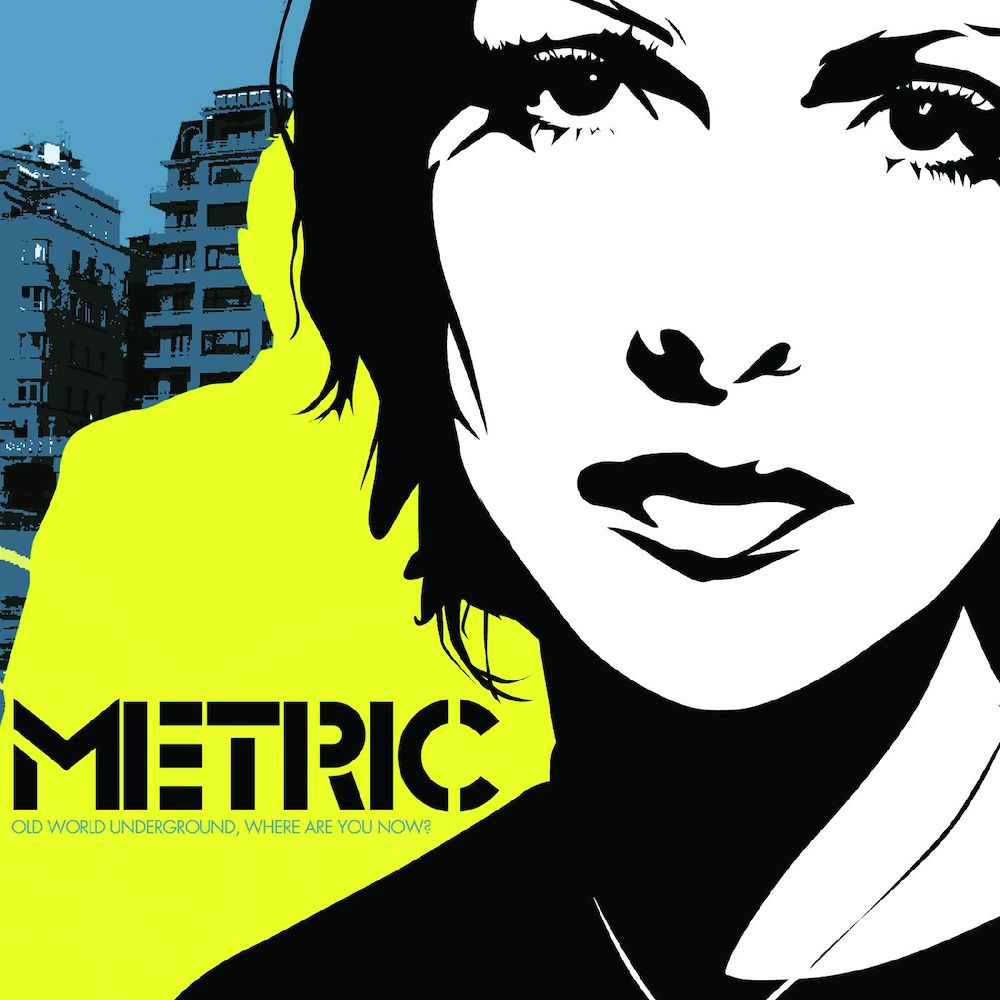- Everloving/Last Gang
- 2003
Metric set out to be a band that could succeed in the mainstream on their own terms. Two decades on from their debut album, they've managed to become one of Canada's last great alternative rock bands. They're an anachronism in a lot of ways, the kind of group that would open for Imagine Dragons on tour while remaining fiercely independent, putting out their own albums and turning down any major labels that came sniffing their way. They've engaged with the more commercial aspects of rock music, but they've never "sold out" in the strictest sense, or given up control over their music. In the process, they've built up a discography to be proud of, one that has innovated on their early promise and rarely underdelivered. And it all (mostly) kicked off with their debut album Old World Underground, Where Are You Now?, released 20 years ago this weekend.
By the time Old World Underground came out, Metric were jaded with the machinations of the music industry. They had been around for a while, and part of their fixation on more old-school methods of rock stardom probably has to do with the fact that they emerged out of a tightly-knit physical scene: the Toronto indie rock community at the turn of the millennium. Haines went to an arts high school with Broken Social Scene's Kevin Drew and Stars' Amy Millan. James Shaw met some of the future members of Stars and Broken Social Scene while studying music in Boston; he followed them to Juilliard and then ended up in Toronto.
Haines and Shaw met in 1996 and started recording music together under the name Mainstream, an indication of their desire to be more than just an underground band. They made their first EP in 1998, changed their name to Metric, and moved to New York City, where they were surrounded by the Meet Me In The Bathroom-era bands. Haines and Shaw lived in a Williamsburg warehouse with roommates who would go on to be in Yeah Yeah Yeahs, TV On The Radio, and Liars. As a duo, Haines and Shaw attracted the attention of a major label and signed a development deal that went nowhere. They recorded a full-length album, Grow Up And Blow Away, that was shelved by the label they had signed to. (It'd eventually be released in 2007.) But soon after that, they recruited a drummer, Joules Scott-Key, who in turn recommended his friend, bassist Josh Winstead, and Metric as they've existed for the past two decades was born.
Metric were informed by the expansive, inclusionary quality of Broken Social Scene, a project that both Haines and Shaw were involved in -- especially around the time of their breakthrough You Forgot It In People, which came out about a year before Old World Underground. But Metric were also more populist in intention. They wanted to make aggressively catchy songs that had something to say. The sound of Old World Underground is mostly mangled, energetic synth-punk. Haines attributed much of the the album's sonic direction to its producer Michael Andrews, who had recently mined the '80s for inspiration for the Donnie Darko soundtrack. The result is brash, raw, and provocative -- songs with serrated guitars and a locked-in rhythm section that's offset by Haines' spiky-sweet delivery, which sounds as intimidating as it does approachable.
A seething frustration courses through their debut album, with songs that explicitly address how hard it can be to maintain your dignity in an industry that encourages you to give up what you believe in for success. That's expressed on songs like "Dead Disco," where they turn their retro fascination into a hook about the unoriginality of some of their peers: "All we get is dead disco, dead funk, dead rock and roll, remodel/ Everything has been done!" And on "The List," which comes for loser A&R guys ("All dressed down to catch a whiff of the buzz/ Smells like the death of the last great cause") and ends with an feverish plea: "Calling from the next hotel, can you put me on the list?"
Their grievances with the scene weren't the only subjects fueling Metric at the time. Old World is also a reflection of the fractured political climate of the time, written and recorded in the years following 9/11 and in the lead-up to the Iraq war. Haines is deeply sardonic about the contemporary state of politics. Album opener "IOU" is damning in its portrayal of the war: "Every 10-year-old enemy soldier/ Thinks falling bombs are shooting stars sometimes/ But she doesn't make wishes on them." On "Succexy," Haines rides an infectious groove to blunt and prescient ends: "All we do is talk, sit, switch screens/ As the homeland plans enemies." They saw the darkness on the horizon: Traditional lines of communication were breaking down. Interpersonal relationships were being replaced by snaking cables. Everything was becoming more connected and everyone was becoming less unique. The lovesick "Combat Baby" sneaks in a dig at how progressive politics in the early '00s had nothing on the radicals of past generations: "Every mighty, mild '70s child beats me," Haines sings, bemoaning a bygone time.
These songs have a narrative sweep, and Haines is a top-notch lyricist. The daughter of a poet, it's clear that Haines grew up with an appreciation for the written word. Take the bratty "Wet Blanket," where Haines turns her ire on a lecherous hanger-on:
Falling for the creep, the body leech, here he comes
Vicious hypnosis, clenched fist saying it's wrong
To want more than a folk song
Underneath the shaker knit, he's a brick wall
She keep falling for the trick, vegetarian sing-along
Give a little kick with your fine thigh-high
Haines delivers her tangled-up poetry with a punchiness that makes full use of her star wattage, still nascent but developing quickly. And some of the most affecting moments on Old World Underground are also the most understated, like the lovely blooping "Calculation Theme," which harkens back to an age long past: "I wish we were farmers/ I wish we knew how to grow sweet potatoes and milk cows/ I wish we were lovers/ But it's for the best." Or the slinking "On A Slow Night," about a friend swallowed up by the fashion world: "True beautiful one/ What have you gone and done?/ I can see all your moves are new/ Tell me, what did that salesman do to you?" On Metric's early songs, Haines frames herself as out of step with the current time: an outsider wondering where it all went wrong.
She opens Metric's first album by growling out its titular question, a lamentation for a culture that maybe never really existed but that the members of the Canadian band were trying to emulate anyway. Metric wanted to embody an old-school cool that they felt had gotten lost over time, in favor of jockeying for record label deals and exclusionary scene politics. With her commanding presence, she presented herself as a rock star for the modern age. Haines saw the power in accessibility, in making music that spoke to younger people without talking down to them. "I see how 14-year-old girls react to me and I think I'm a good role model," Haines reflected in a 2004 interview. "Rock star, maybe not, but I'm willing to play with it for a little while, until my hair gets gray."
We rely on reader subscriptions to deliver articles like the one you're reading. Become a member and help support independent media!






